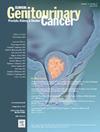Comorbidity Burden and Effectiveness of Immunotherapy in Metastatic Renal Cell Carcinoma
IF 2.7
3区 医学
Q3 ONCOLOGY
引用次数: 0
Abstract
Background
Comorbid conditions complicate the care of patients with cancer and frequently cause exclusion of patients from clinical trials.
Methods
Data from patients with metastatic renal cell carcinoma (mRCC) treated with immune checkpoint inhibitor (ICI)-based combinations in the first line setting were collected. The comorbidity burden was assessed at baseline by using the age-adjusted Charlson Comorbidity Index (CCI). Patients were stratified into 2 groups to predict overall survival (OS) through maximally selected rank statistics. The primary outcomes were time to treatment failure (TTF) and OS. The secondary outcome was the rate of adverse events (AEs) leading to dose reduction or treatment discontinuation.
Results
A total of 304 patients were included. Most patients were male (73%), had clear cell RCC (91.4%), and were treated with nivolumab + ipilimumab (53.6%). The most common comorbidities were diabetes (18.4%), followed by previous myocardial infarction (12.8%), chronic kidney disease (6.6%), and chronic pulmonary disease (5.6%). After adjusting for baseline prognostic factors in mRCC including the International mRCC Database Consortium (IMDC) risk, TTF (Hazard Ratio [HR], 1.51, 95% Confidence Interval [CI], 1.09-2.10, P = .013) and OS (HR: 1.98, 95% CI, 1.33-2.94, P = .001) were worse in the CCI-high group vs. the CCI-low group. The rates of AEs leading to dose reduction or treatment discontinuation were comparable between the 2 groups.
Conclusions
Despite similar rates of AEs leading to dose reduction or treatment discontinuation, a high comorbidity burden is associated with worse outcomes in patients with mRCC treated with first-line ICI-based therapies. Our study underscores the necessity for a multidimensional approach to assess the comorbidity burden in patients with mRCC receiving ICI-based combinations.
转移性肾细胞癌的合并症、负担和免疫治疗效果。
背景:合并症使癌症患者的护理复杂化,并经常导致患者被排除在临床试验之外。方法:收集一线使用免疫检查点抑制剂(ICI)联合治疗的转移性肾细胞癌(mRCC)患者的数据。使用年龄调整的Charlson合并症指数(CCI)在基线时评估合并症负担。将患者分为两组,通过最大选择的秩统计预测总生存期(OS)。主要终点为治疗失败时间(TTF)和OS。次要结局是导致剂量减少或停止治疗的不良事件(ae)发生率。结果:共纳入304例患者。大多数患者为男性(73%),透明细胞RCC(91.4%),接受纳武单抗+伊匹单抗治疗(53.6%)。最常见的合并症是糖尿病(18.4%),其次是既往心肌梗死(12.8%)、慢性肾脏疾病(6.6%)和慢性肺部疾病(5.6%)。在调整了包括国际mRCC数据库联盟(IMDC)风险在内的mRCC的基线预后因素后,cci高组的TTF(风险比[HR], 1.51, 95%可信区间[CI], 1.09-2.10, P= 0.013)和OS(风险比:1.98,95% CI, 1.33-2.94, P= 0.001)比cci低组更差。导致剂量减少或停药的不良事件发生率在两组之间具有可比性。结论:尽管不良事件导致剂量减少或停药的发生率相似,但在接受一线ci治疗的mRCC患者中,较高的合并症负担与较差的预后相关。我们的研究强调了采用多维方法评估mRCC患者接受基于ci的联合治疗的合并症负担的必要性。
本文章由计算机程序翻译,如有差异,请以英文原文为准。
求助全文
约1分钟内获得全文
求助全文
来源期刊

Clinical genitourinary cancer
医学-泌尿学与肾脏学
CiteScore
5.20
自引率
6.20%
发文量
201
审稿时长
54 days
期刊介绍:
Clinical Genitourinary Cancer is a peer-reviewed journal that publishes original articles describing various aspects of clinical and translational research in genitourinary cancers. Clinical Genitourinary Cancer is devoted to articles on detection, diagnosis, prevention, and treatment of genitourinary cancers. The main emphasis is on recent scientific developments in all areas related to genitourinary malignancies. Specific areas of interest include clinical research and mechanistic approaches; drug sensitivity and resistance; gene and antisense therapy; pathology, markers, and prognostic indicators; chemoprevention strategies; multimodality therapy; and integration of various approaches.
 求助内容:
求助内容: 应助结果提醒方式:
应助结果提醒方式:


